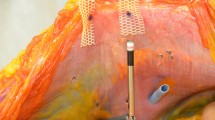Abstract
Introduction
Laparoscopic mesh repair has become an increasingly common method for repairing incisional hernias. The current method for fixating mesh to the abdominal wall includes tacking the mesh to the peritoneum and fascia and suturing the mesh to the fascia with trans-fascial sutures. The iMESH Stitcher™ is a stitching device developed to both simplify and expedite this procedure by passing the suture from one arm of the iMESH stitcher™ to the other. The device enables a stitch to be created in three quick moves using only one hand. We compared both the efficacy and procedure time of trans-fascial mesh fixation when performed with the iMESH stitcher™ as compared to the standard suture passer method.
Methods
A mesh patch was installed on the internal abdominal wall of two pigs. Surgical residents and Medical students were participants in the study and were trained in both techniques. Each participant was asked to perform six fixations with each technique. The procedural time required for both fixation techniques was recorded. Participants were asked to assess subjectively the relative difficulty of each technique on a scale of 1–10 (10 = most difficult).
Results
Sixteen residents and students performed a total of 12 mesh fixations, each performing 6 fixations with each technique. Average mesh fixation suture time using the suture passer technique was 44 s for residents and 47 s for students. Average fixation suture time using the iMESH stitcherTM was 17 s for residents and 15 s for students. The average difficulty score for the suture passer technique was 6.1 as compared to 2.9 with iMESH stitcher™.
Conclusion
Trans-fascial fixation with the iMESH Stitcher™ took significantly less time than the standard suture passer method. The iMESH Stitcher™ significantly simplifies the procedure of transfascial fixation and potentially reduces technical difficulties.



Similar content being viewed by others
References
Hawn MT, Snyder CW, Graham LA, Gray SH, Finan KR, Vick CC (2010) Long-term follow-up of technical outcomes for incisional hernia repair. J Am Coll Surg 210:648–657
McGreevy JM, Goodney PP, Birkmeyer CM, Finlayson SR, Laycock WS, Birkmeyer JD (2003) A prospective study comparing the complication rates between laparoscopic and open ventral hernia repairs. Surg Endosc 17:1778–1780
Itani KM, Hur K, Kim LT, Anthony T, Berger DH, Reda D, Neumayer L (2010) Comparison of laparoscopic and open repair with mesh for the treatment of ventral incisional hernia: a randomized trial. Arch Surg 145:322–328
Kingsnorth A, Banerjea A, Bhargava A (2009) Incisional hernia repair—laparoscopic or open surgery? Ann R Coll Surg Engl 91:631–636
Bucher P, Pugin F, Morel P (2009) Single port laparoscopic repair of primary and incisional ventral hernia. Hernia 13:569–570
Horgan S, Cullen JP, Talamini MA, Mintz Y, Ferreres A, Jacobsen GR, Sandler B, Bosia J, Savides T, Easter DW, Savu MK, Ramamoorthy SL, Whitcomb E, Agarwal S, Lukacz E, Dominguez G, Ferraina P (2009) Natural orifice surgery: initial clinical experience. Surg Endosc 23:1512–1518
Bencini L, Sánchez LJ (2004) Learning curve for laparoscopic ventral hernia repair. Am J Surg 187:378–382
Santos BF, Enter D, Soper NJ, Hungness ES (2010) Single-incision laparoscopic surgery (SILS) versus standard laparoscopic surgery: a comparison of performance using a surgical simulator. Surg Endosc [E-pub ahead of print] doi:10.1007/s00464-010-1197-5
Conflict of interest
R.E., M.A.-G., A.S., A.K., N.S. and A.I.R. have no financial interests regarding the iMESH stitcher™ device or anything else to disclose. Y.M. is a medical consultant for EasyLap Ltd., the manufacturer of the iMESH stitcher™ device.
Author information
Authors and Affiliations
Corresponding author
Rights and permissions
About this article
Cite this article
Elazary, R., Abu-Gazala, M., Schlager, A. et al. Trans-fascial laparoscopic mesh fixation: a procedural comparison using the standard suture passer versus iMESH stitcher™ device. Hernia 15, 321–324 (2011). https://doi.org/10.1007/s10029-011-0789-x
Received:
Accepted:
Published:
Issue Date:
DOI: https://doi.org/10.1007/s10029-011-0789-x




